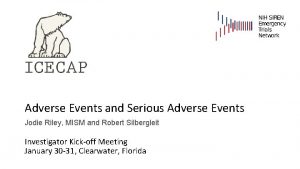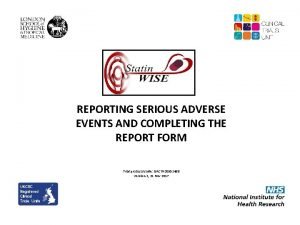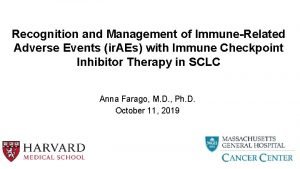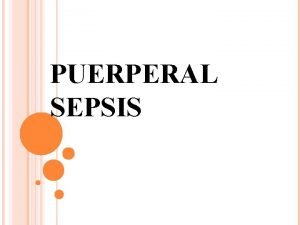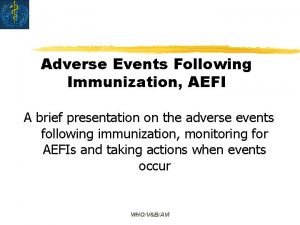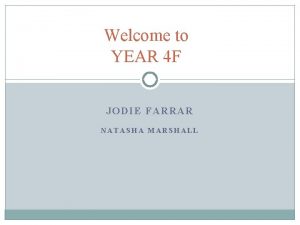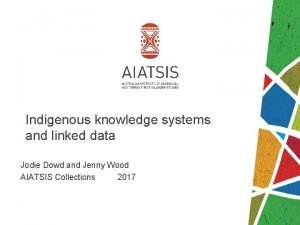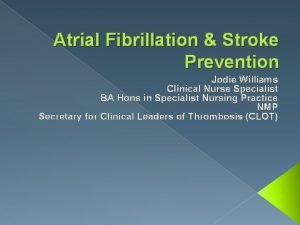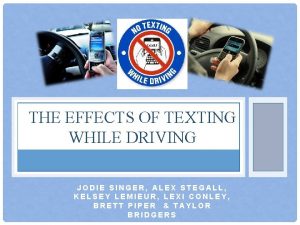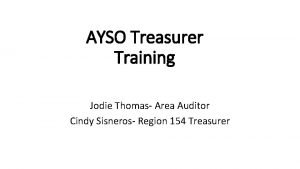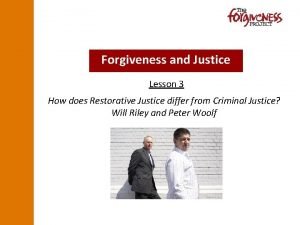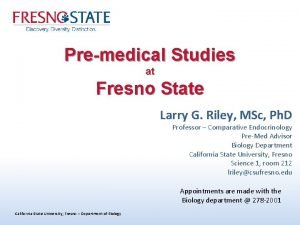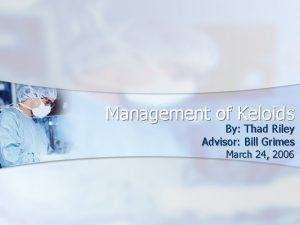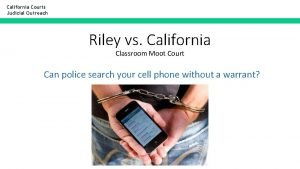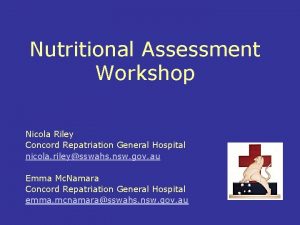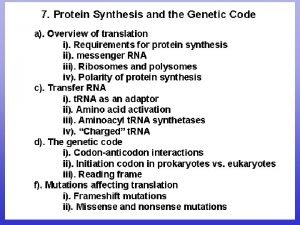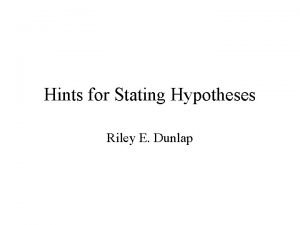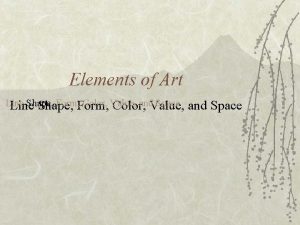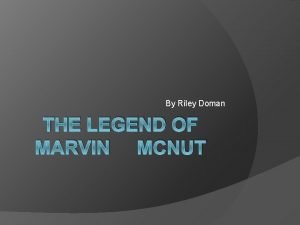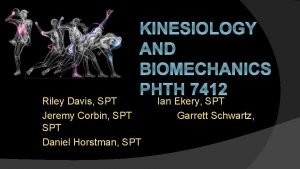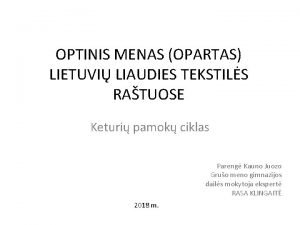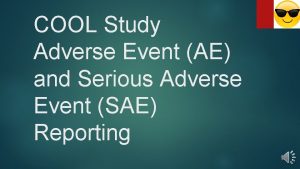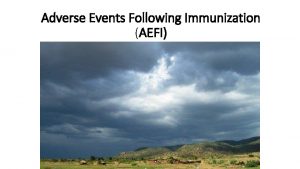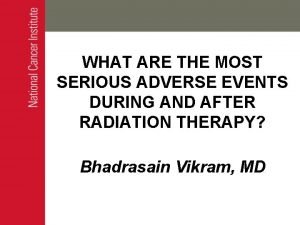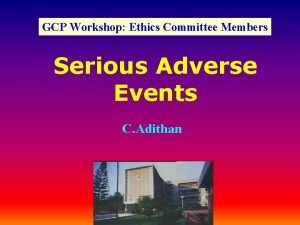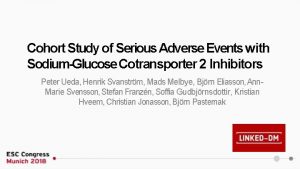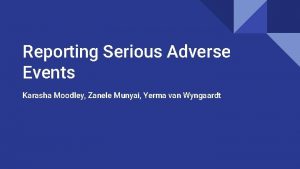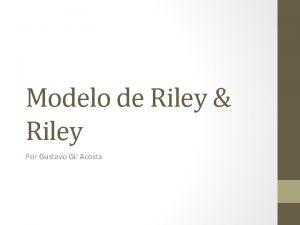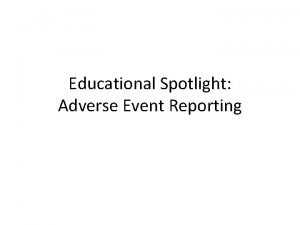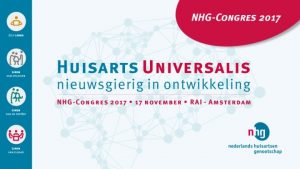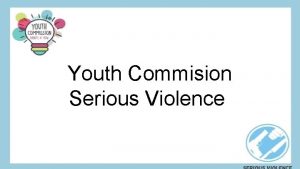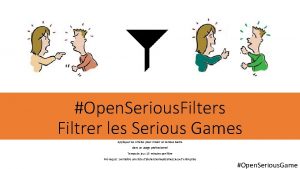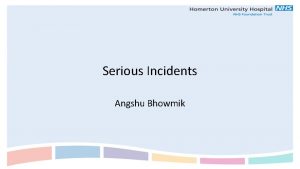Adverse Events and Serious Adverse Events Jodie Riley


































- Slides: 34

Adverse Events and Serious Adverse Events Jodie Riley, MISM and Robert Silbergleit Investigator Kick-off Meeting January 30 -31, Clearwater, Florida

Adverse Events ● Adverse Events (AEs) are “. . . any untoward medical occurrence in a subject that was not previously identified which does not necessarily have a causal relationship to the study drug…” ● Events existing prior to randomization should not be reported as AEs, unless there is a change in severity. ● Pre-existing conditions that are discovered after randomization are not adverse events. These should be documented as medical history. ● Abnormal lab values collected after randomization that are considered to be clinically significant by the site investigator are adverse events.

Serious Adverse Events (SAEs): ● Are Fatal ● Are Life-threatening ● Result in hospitalization/prolonging of hospitalization – excluding optional, pre-planned surgery ● Result in disability/congenital anomaly ● Require intervention to prevent permanent impairment or damage

Reporting AEs ● Reported on Form 104 – Adverse Event Case Report Form (CRF) ● One AE per CRF ● Report diagnosis, not symptoms ○ Fever, cough, chest pain, crackles = pneumonia ● Avoid abbreviations/colloquialisms

Reporting AEs ● Death, surgery, intubation, etc. are NOT adverse events. They are outcomes of adverse events. ● All AEs will be coded using Med. DRA. ● A new feature of Web. DCUTM will auto-populate the Lowest Level Term when 3 or more letters are entered into the name field. ● Pick the highest level of specificity.

Reporting Requirements for AEs ● AE reporting – from Randomization through Day 6 or Hospital Discharge, whichever comes first ● SAE reporting – from Randomization through End of Study

Data Entry Timelines for AEs ● Non-serious AEs must be entered and submitted into Web. DCUTM within 5 days of data collection. ● SAEs must be entered and submitted into Web. DCUTM within 24 hours of discovery.

Reporting SAEs require additional information to be submitted on the AE CRF: ● Detailed description of the event ● Relevant tests/laboratory data ● Relevant history and pre-existing conditions ● Concomitant medications

SAE Narratives ● Narratives assist the Independent Medical Safety Monitor (IMSM) in reviewing the event. ● Narratives are pre-populated into the Med. Watch form, if expedited reporting is required. ● Remove any protected health information (PHI) from the narrative ○ i. e. , subject, physician or institution name

IMSM Review Process ● Site enters data and submits AE CRF into Web. DCUTM ● Automatic e-mail notifications to Site Manager (SM) and Internal Quality Reviewer (IQR) ● If SAE and data is sufficient, automatic e-mail notification sent to the IMSM ● IMSM blindly reviews the event and indicates whether it is serious, unexpected and study intervention-related ● SM closes review process


Adverse Events – key points • Do not report events EXISTING PRIOR to randomization (unless there is a change in severity) • Report the DIAGNOSIS, not the symptoms: Fever, cough, chest pain, crackles = pneumonia • Report the PATHOLOGY, not the outcome or treatment Not ‘death’ but the event that caused death CD

Relatedness algorithm Not Related • The timing is wrong and there was clearly another cause Reasonable Possibly (2 of 3) • Timing is suggestive. • Not readily caused by something else • This is something the intervention is known to cause. Unlikely (both of the following, but timing doesn’t matter) • Another cause is possible • Not something the intervention is known to cause Definitely (must have all 3) • Timing suggests intervention caused the problem. • No other possible cause. • This is something the intervention is known to cause.

While being screened for enrollment in ICECAP, a 52 yo comatose survivor of OHCA has a prolonged seizure requiring treatment which resolves after several rounds of anticonvulsants. She is subsequently appropriately enrolled. Anticonvulsant medications are continued after enrollment as is continuous EEG monitoring. Adverse event? Serious? Yes / No Related? A. Not related Unlikely Reasonable Possibly Definitely B. C. D.

While being screened for enrollment in ICECAP, a 52 yo comatose survivor of OHCA has a prolonged seizure requiring treatment which resolves after several rounds of anticonvulsants. She is subsequently appropriately enrolled. Anticonvulsant medications are continued after enrollment as is continuous EEG monitoring. Brief electrographic seizures are seen. No AED are added or changed. Adverse event? Serious? Yes / No Related? A. Not related Unlikely Reasonable Possibly Definitely B. C. D.

While being screened for enrollment in ICECAP, a 52 yo comatose survivor of OHCA has a prolonged seizure requiring treatment which resolves after several rounds of anticonvulsants. She is subsequently appropriately enrolled. Despite continued anticonvulsants she develops more seizures in the ICU, and her propofol is titrated up from mild sedation to burst suppression. Adverse event? Serious? Yes / No Related? A. Not related Unlikely Reasonable Possibly Definitely B. C. D.

A 62 yo with OHCA aspirates while being endotracheally intubated, and is subsequently appropriately enrolled in ICECAP. On hospital day 2, he develops pneumonitis, and his PEEP is increased to improve recruitment. Three hours later he decompensates, is found to have a pneumothorax. A chest tube is placed without complications. Adverse event? Serious? Yes / No Related? A. Not related Unlikely Reasonable Possibly Definitely B. C. D.

A 62 yo with OHCA has a surface cooling device applied and is subsequently enrolled in BOOST. On hospital day 4, a patch of skin under the cooling pad appears to have a low grade thermal injury. The cooling pad is repositioned to avoid further injury. Adverse event? Serious? Yes / No Related? A. Not related Unlikely Reasonable Possibly Definitely B. C. D.

An 48 yo with OHCA at the gym is appropriately enrolled. On ICU day 3 his routine metabolic panel shows a potassium of 3. 2 and an AST of 99 for which he receives no specific intervention. Adverse event? Serious? Yes / No Related? A. Not related Unlikely Reasonable Possibly Definitely B. C. D.

An 48 yo with OHCA at the gym is appropriately enrolled. On ICU day 3, after rewarming, his routine metabolic panel shows a potassium of 3. 2 and an AST of 99 for which he receives, by an electrolyte replacement protocol, 40 m. Eq of potassium by orogastric tube. Adverse event? Serious? Yes / No Related? A. Not related Unlikely Reasonable Possibly Definitely B. C. D.

An 85 yo with OHCA at the casino is appropriately enrolled. On ICU day 3, while still at a target temperature of 33 degrees, his Foley catheter is accidentally and traumatically discontinued with the balloon inflated. He has extensive urethral bleeding, urology is consulted, a new urinary catheter is placed, but he continues to ooze for 14 hours. He has 2 gram drop in hemoglobin for which he is transfused. Adverse event? Serious? Yes / No Related? A. Not related Unlikely Reasonable Possibly Definitely B. C. D.

An 48 yo with OHCA at the gym is appropriately enrolled. On ICU day 4, he has a transient episode of hypoxia and tachycardia and undergoes CT pulmonary angiogram. The CT shows no evidence of PE, but also shows numerous rib fractures not seen on prior chest X-rays. Adverse event? Serious? Yes / No Expected? Yes / No Related? A. Not related Unlikely Reasonable Possibly Definitely B. C. D.

“I just have to create a few loose ends for other people to clear up, and then I can out of here. ”

Write good SAE narratives Be concise but complete (not comprehensive) • Include only the pertinent PMH and HPI • Describe the event • Describe the response • Describe the outcome • And say when each of those happened Look for and respond to queries promptly

How are SAE narratives used? Medical safety monitor DSMB Study Leadership

Example narrative A 40 year old female bicyclist suffered a TBI with SAH and was appropriately enrolled at 7/10/19. On 7/12/19, she returned to the ICU from radiology for a follow up head CT. At 23: 15 she became hypotensive to 85/45, tachycardic to 122, and had an increased Fi. O 2 requirement. A chest x-ray at 23: 35 was unremarkable, but a PE protocol chest CT at 00: 45 on 7/13/19 demonstrated saddle pulmonary emboli and evidence of right heart strain. Interventional radiology performed suction thrombectomy and IVC filter placement later that day. On 7/14/19 she was hemodynamically stable, and there were no further thromboembolic complications.

Too much 35 y. o. male with a history of anxiety, bipolar affective disorder, schizophrenia, and previous seizure event thought to be Et. OH related presented to enrolling center ED via EMS 2/8/17 at 20: 47 with seizures. Seizure in route abated with 4 mg midazolam IM EMS administered. On initial assessment patient was sedated, but responded to noxious stimuli. Sedation thought to be due to Et. OH, versed, and post-ictal state. Labs and CT head ordered. In CT patient had repeat seizure. He was given midazolam 3 mg IM and was brought back to ER. He appeared to continue to be having seizure so additional midazolam 3 mg IV was given. Seizure appeared to resolve. Neurology consulted to ER. Patient return of seizures occurred at approximately 2240. He was given an additional lorazepam 2 mg IV. Seizure continued for 5 minutes so ESETT drug was given. Study drug infusion started at 23: 01. During infusion, pt appeared to have aspiration event. Infusion completed and patient stopped seizing and withdrew from nailbed pressure. At 20 minute assessment he was still responding to noxious stimulation. He was intubated for airway protection due to apparent aspiration event. He was sedated with propofol post intubation. Pt was admitted to the ICU for further diagnosis and management. 60 minute assessment at 00: 15 revealed pt was sedated but withdrew from nailbed pressure. On 2/10/17 about 13: 15 he was electively extubated. 2/10/17 1900 many verbally aggressive outbursts noted. 2/11/17 09: 03 patient left AMA, after psychiatric evaluation

Too much - continued 35 y. o. male with a history of anxiety, bipolar affective disorder, schizophrenia, complex psychiatric history and previous seizure event thought to be Et. OH related and prior alcohol related seizures… presented to enrolling center ED via EMS 2/8/17 at 20: 47 with seizures. Seizure in route abated with 4 mg midazolam IM EMS administered. On initial assessment patient was sedated, but responded to noxious stimuli. Sedation thought to be due to Et. OH, versed, and post-ictal state. Labs and CT head ordered. In CT patient had repeat seizure. He was given midazolam 3 mg IM and was brought back to ER. He appeared to continue to be having seizure so additional midazolam 3 mg IV was given. Seizure appeared to resolve. Neurology consulted to ER. Patient return of seizures occurred at approximately 2240. He was given an additional lorazepam 2 mg IV. Seizure continued for 5 minutes so ESETT drug was given. Study drug infusion started at 23: 01. During infusion, pt appeared to have aspiration event. …had stuttering status epilepticus, received midazolam 10 mg and lorazepam 2 mg in divided doses over 2 hours, and enrolled on 2/8/17 at 23: 01, followed by an aspiration event and transient hypoxia. ….

Too much - continued Infusion completed and patient stopped seizing and withdrew from nailbed pressure. At 20 minute assessment he was still responding to noxious stimulation. He was intubated for airway protection due to apparent aspiration event. He stopped seizing but remained poorly responsive. He was endotracheally intubated at 23: 25 for airway protective and decreased level of consciousness and risk of further aspiration. He was sedated with propofol post intubation. Pt was admitted to the ICU for further diagnosis and management. 60 minute assessment at 00: 15 revealed pt was sedated but withdrew from nailbed pressure. He was sedated with propofol and admitted to ICU. Normal CXR and no sequelae of aspiration on 2/9/17. On 2/10/17 about 13: 15 he was electively extubated. 2/10/17 1900 many verbally aggressive outbursts noted. 2/11/17 09: 03 patient left AMA, after psychiatric evaluation Extubated on 2/10/17.

Too much - resolution 35 y. o. male with a history of anxiety, bipolar affective disorder, schizophrenia, and previous seizure event thought to be Et. OH related presented to enrolling center ED via EMS 2/8/17 at 20: 47 with seizures. Seizure in route abated with 4 mg midazolam IM EMS administered. On initial assessment patient was sedated, but responded to noxious stimuli. Sedation thought to be due to Et. OH, versed, and post-ictal state. Labs and CT head ordered. In CT patient had repeat seizure. He was given midazolam 3 mg IM and was brought back to ER. He appeared to continue to be having seizure so additional midazolam 3 mg IV was given. Seizure appeared to resolve. Neurology consulted to ER. Patient return of seizures occurred at approximately 2240. He was given an additional lorazepam 2 mg IV. Seizure continued for 5 minutes so ESETT drug was given. Study drug infusion started at 23: 01. During infusion, pt appeared to have aspiration event. Infusion completed and patient stopped seizing and withdrew from nailbed pressure. At 20 minute assessment he was still responding to noxious stimulation. He was intubated for airway protection due to apparent aspiration event. He was sedated with propofol post intubation. Pt was admitted to the ICU for further diagnosis and management. 60 minute assessment at 00: 15 revealed pt was sedated but withdrew from nailbed pressure. On 2/10/17 about 13: 15 he was electively extubated. 2/10/17 1900 many verbally aggressive outbursts noted. 2/11/17 09: 03 patient left AMA, after psychiatric evaluation A 35 yo with complex psychiatric history and prior alcohol related seizures had stuttering status epilepticus, received midazolam 10 mg and lorazepam 2 mg in divided doses over 2 hours, and enrolled on 2/8/17 at 23: 01, followed by an aspiration event and transient hypoxia. He stopped seizing but remained poorly responsive. He was endotracheally intubated at 23: 25 for airway protective and decreased level of consciousness and risk of further aspiration. He was sedated with propofol and admitted to ICU. Normal CXR and no sequelae of aspiration on 2/9/17. Extubated on 2/10/17.

Not enough • Blood culture positive for beta hemolytic strep, left peripheral line. Patient started Levaquin 750 mg oral tablet qd x 10 days

Not enough • Blood culture positive for beta hemolytic strep, left peripheral line. Patient started Levaquin 750 mg oral tablet qd x 10 days • A 42 yo with epilepsy and prior TBI was enrolled on 3/15/17 at 9: 02 PM. On [date? ] she had fever, leukocytosis, and underwent a workup for an infectious source. Blood culture grew strep agalactiae sensitive to ceftriaxone and levofloxacin, but no other source was found. She was treated with ceftriaxone IV x 4 days, and levofloxacin PO x 10 days, and had no further fevers.

Style points • Use generic drug names • Use a spell checker • Have the site PI read critically

Questions?
 Jodie riley
Jodie riley Riley riley modeli nedir
Riley riley modeli nedir Serious adverse event reconciliation
Serious adverse event reconciliation Adverse events in hospital
Adverse events in hospital Adverse events in hospital
Adverse events in hospital Puerperal sepsis
Puerperal sepsis Aefi examples
Aefi examples Jodie farrar
Jodie farrar Jodie shaw page 3
Jodie shaw page 3 Jodie dowd
Jodie dowd Jodie fuster
Jodie fuster What does gwv mean in scentsy
What does gwv mean in scentsy Jodie singer
Jodie singer Duties of treasurer
Duties of treasurer Peter woolf restorative justice
Peter woolf restorative justice Riley rink at hunter park
Riley rink at hunter park Rayleigh scattering
Rayleigh scattering Larry riley fresno state
Larry riley fresno state Thad riley
Thad riley Riley v california summary
Riley v california summary Riley stee
Riley stee Nicola riley
Nicola riley Riley day syndrome
Riley day syndrome Dr luke riley
Dr luke riley Riley e. dunlap
Riley e. dunlap Bridget riley cataract 3 1967
Bridget riley cataract 3 1967 Bridget riley arrest 1
Bridget riley arrest 1 Bridget riley
Bridget riley Bridget riley
Bridget riley Doman reclamation
Doman reclamation Rib costal groove
Rib costal groove Jenn riley mcgill
Jenn riley mcgill Riley olsen
Riley olsen Steve riley microsoft
Steve riley microsoft Op menas
Op menas
